
USS Brandywine was a wooden-hulled, three-masted frigate of the United States Navy bearing 44 guns which had the initial task of conveying the Marquis de Lafayette back to France. She was later recommissioned a number of times for service in various theaters, such as in the Mediterranean, in China and in the South Atlantic Ocean.
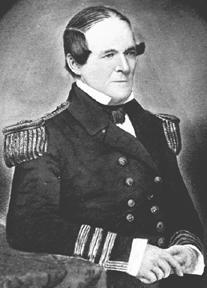
Cornelius Kinchiloe Stribling was a rear admiral in the United States Navy who served during the War of 1812, the Second Barbary War, the Mexican–American War, and the American Civil War.

Commodore Josiah Tattnall was an officer in the United States Navy during the War of 1812, the Second Barbary War and the Mexican–American War. He later served in the Confederate Navy during the American Civil War.

The first Vandalia was an 18-gun sloop-of-war in the United States Navy during the Second Seminole War and the American Civil War. She was named for the city of Vandalia, Illinois.
The second USS Ontario was a three-masted, wooden-hulled sloop of war in the United States Navy, bearing 16 guns, and saw service during and following the years of the War of 1812 and in the Second Barbary War. Ontario was built by Thomas Kemp, Baltimore, Maryland, in 1813; blockaded in Chesapeake Bay through the War of 1812; and sailed from New York for the Mediterranean on 20 May 1815, Master Commandant Jesse D. Elliott in command.
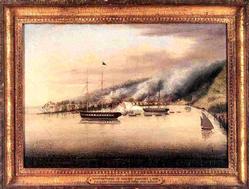
The first John Adams was originally built in 1799 as a frigate for the United States Navy, converted to a corvette in 1809, and later converted back to a frigate in 1830. Named for American Founding Father and president John Adams, she fought in the Quasi-War, the First and Second Barbary Wars, the War of 1812, the Mexican–American War and the American Civil War. At the end of her career, she participated in the Union blockade of South Carolina's ports. She then participated in the raid on Combahee Ferry that Harriet Tubman, the former slave and Union operative, organized with Union colonel Montgomery. John Adams led three steam-powered gunboats up the Harbor River to Port Royal. The squadron relied on local black mariners to guide it past mines and fortifications. The squadron freed 750+ slaves and unsettled the Confederacy. Tubman was the first woman in U.S. history to plan and execute an armed expedition.

USS Peacock was a sloop-of-war in the United States Navy during the War of 1812.

USS Erie was a three-masted, wooden-hulled sloop-of-war of the United States Navy in the early 19th century.

The second USS Lexington was a sloop in the United States Navy built at the New York Navy Yard in Brooklyn, New York, in 1825; and commissioned on 11 June 1826, Master Commandant William B. Shubrick in command.

The first USS Jamestown was a sloop-of-war in the United States Navy during the Mexican–American War and the American Civil War.

USS St. Louis was a sloop-of-war in the United States Navy through most of the 19th century.

The East India Squadron, or East Indies Squadron, was a squadron of American ships that existed in the nineteenth century. It focused on protecting American interests in the Far East, while the Pacific Squadron concentrated on the western coasts of the Americas and the South Pacific Ocean. Its duties included the Yangtze River Patrol in China. The East India Squadron was established in 1835 and existed until it became part of the Asiatic Squadron in 1868.

The Yorktown class was a class of three steel-hulled, twin-screw gunboats built for the United States Navy beginning in 1887. All three ships of the class were named after cities near American Revolutionary War battles.
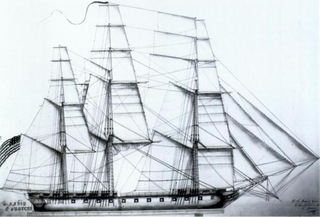
The West Indies Squadron, or the West Indies Station, was a United States Navy squadron that operated in the West Indies in the early nineteenth century. It was formed due to the need to suppress piracy in the Caribbean Sea, the Antilles and the Gulf of Mexico region of the Atlantic Ocean. This unit later engaged in the Second Seminole War until being combined with the Home Squadron in 1842. From 1822 to 1826 the squadron was based out of Saint Thomas Island until the Pensacola Naval Yard was constructed.

The West Indies Anti-Piracy Operations refer to the United States Navy presence in the Antilles, and surrounding waters, which fought against pirates. Between 1814 and 1825, the American West Indies Squadron constantly pursued pirates on sea and land, primarily around Cuba and Puerto Rico.After the capture of Roberto Cofresi in 1825, acts of piracy became rare, and the operation was considered a success, although limited occurrences went on until slightly after the start of the 20th century.
George Frederick Pearson was rear-admiral of the United States Navy, commanding the Pacific Squadron during the later part of the American Civil War.
Edmund Roberts was an American diplomat. Appointed by President Andrew Jackson, he served as the United States' first envoy to the Far East, and went on USS Peacock on non-resident diplomatic missions to the courts of Cochinchina, Thailand ("Siam") and Muscat and Oman during the years 1832–6.

Rear Admiral Henry Kuhn Hoff was a United States Navy officer. During his long career, he took part in combat in Sumatra and in the American Civil War.
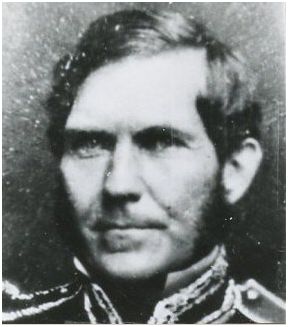
Commodore Cicero Price was an officer in the United States Navy. He served in the American Civil War and was commander of the East India Squadron.
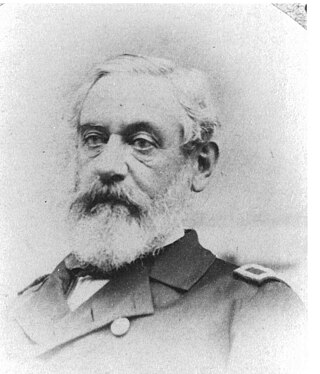
Gustavus Hall Scott was an officer in the United States Navy who served in the Second Seminole War and the American Civil War. He rose to the rank of rear admiral and late in his career was commander-in-chief of the North Atlantic Squadron.















